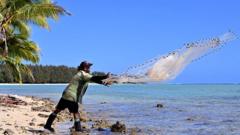The discovery showcases intricate architecture like temple pyramids and public plazas, suggesting the Maya civilization was even more complex than previously understood.
Lost Maya City Unearthed by Archaeologists in Mexico

Lost Maya City Unearthed by Archaeologists in Mexico
A newly uncovered Maya city named Valeriana reveals the advanced civilization's expansive reach.
In an extraordinary find, archaeologists have uncovered a previously lost Maya city, named Valeriana, hidden deep within the dense jungles of Campeche, Mexico. Located east of Dos Lagunas and just a short distance from a busy highway, the ancient site had remained virtually unknown to researchers until now, shrouded by centuries of vegetation.
Marcello Canuto, an archaeologist from Tulane University, expressed the humbling realization that significant historical sites can exist just beyond the limits of visibility, emphasizing the power of nature in concealing human history. The site was identified not through traditional excavation, but through aerial scans conducted for ecological research—underscoring the innovative methods now employed in archaeology.
Luke Auld-Thomas, a doctoral student at Tulane who identified the site, remarked that Valeriana has all the quintessential features of a classic Maya city, including temple pyramids, a palace complex, spacious public plazas, and sophisticated water management systems such as reservoirs and dams. The ruins also extend to residential buildings, agricultural terraces, and evidence suggesting organized urban planning.
This groundbreaking discovery not only enriches our understanding of the Maya civilization but also highlights the continued potential for significant archaeological finds buried within the natural landscape, waiting to reveal their secrets to the world.
Marcello Canuto, an archaeologist from Tulane University, expressed the humbling realization that significant historical sites can exist just beyond the limits of visibility, emphasizing the power of nature in concealing human history. The site was identified not through traditional excavation, but through aerial scans conducted for ecological research—underscoring the innovative methods now employed in archaeology.
Luke Auld-Thomas, a doctoral student at Tulane who identified the site, remarked that Valeriana has all the quintessential features of a classic Maya city, including temple pyramids, a palace complex, spacious public plazas, and sophisticated water management systems such as reservoirs and dams. The ruins also extend to residential buildings, agricultural terraces, and evidence suggesting organized urban planning.
This groundbreaking discovery not only enriches our understanding of the Maya civilization but also highlights the continued potential for significant archaeological finds buried within the natural landscape, waiting to reveal their secrets to the world.





















